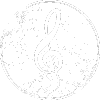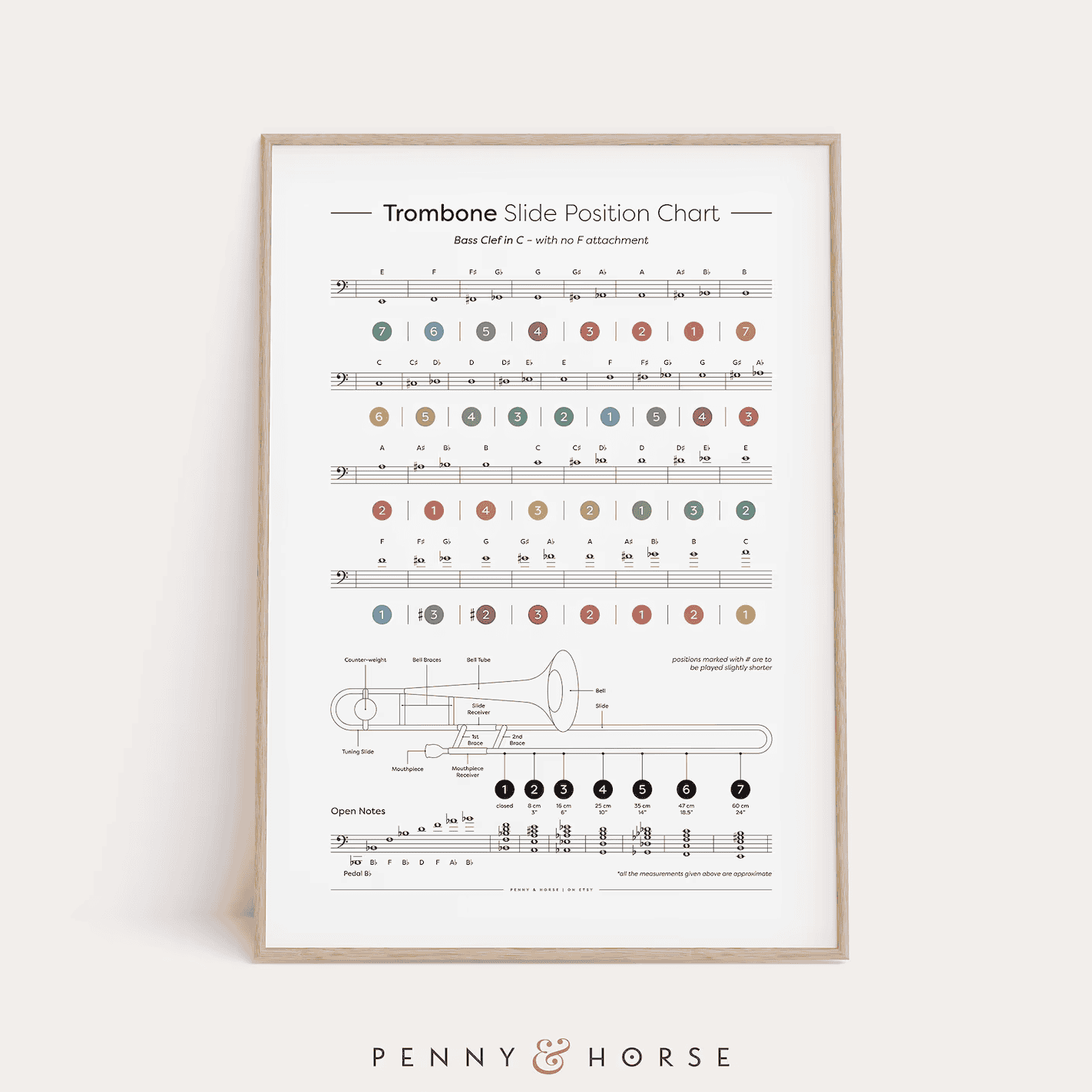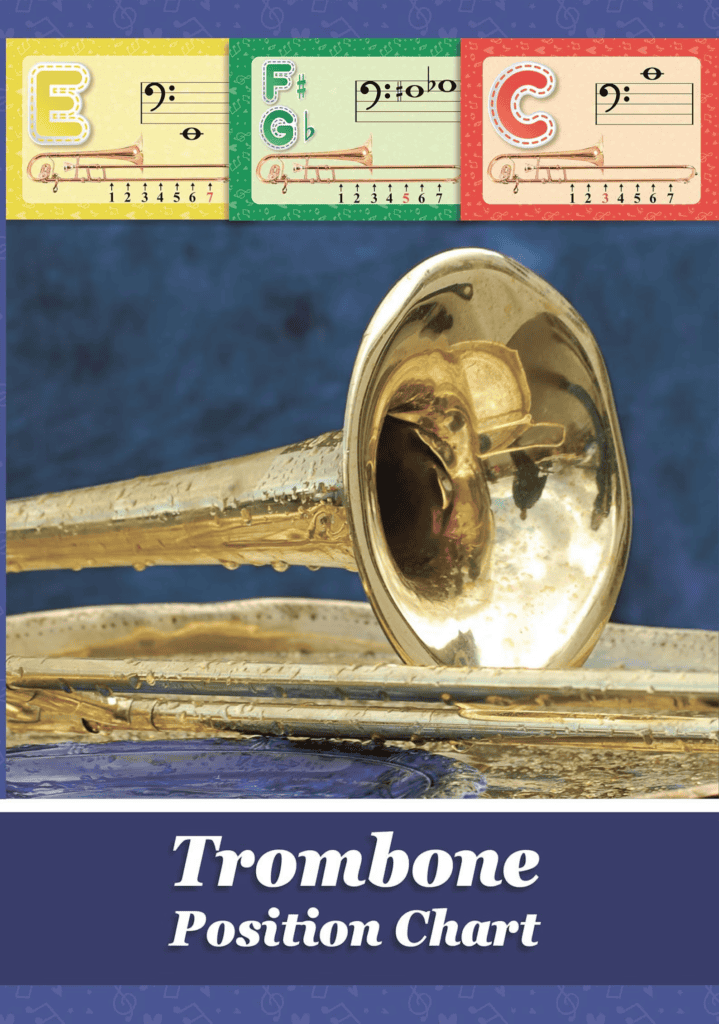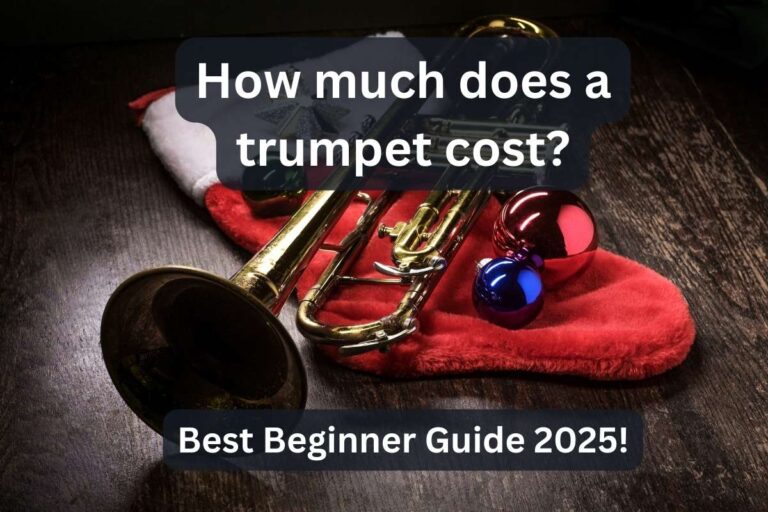Trombone First steps — Learn Trombone Slide Chart PDF in 2025

Are you a trombonist looking to improve your accuracy and speed? Look no further than the Trombone Slide Chart!
In this comprehensive guide, we will explore Trombone Slide Charts, how to read them, and why it is important for brass instruments.
This article will provide the best tips for mastering the chart, from understanding the positions to identifying alternate positions. Get ready to slide between positions, use a metronome, and memorize common positions to take your trombone playing to the next level.
Key Takeaways:
The trombone slide chart is an essential tool for trombonists — a visual representation of the slide positions and alternate positions for accuracy and speed.
Understanding the positions and identifying alternate positions are crucial in mastering the slide chart and improving overall playing ability.
To master the trombone slide chart, practice sliding between positions, use a metronome and memorize commonly used positions for faster and more accurate playing.
What is a Trombone Slide Chart?
A Trombone Slide Chart illustrates the various slide positions on the trombone, helping yout identify the correct positions to play different notes.
These charts typically consist of a diagram showing the length of the trombone slide and the corresponding positions for each note.
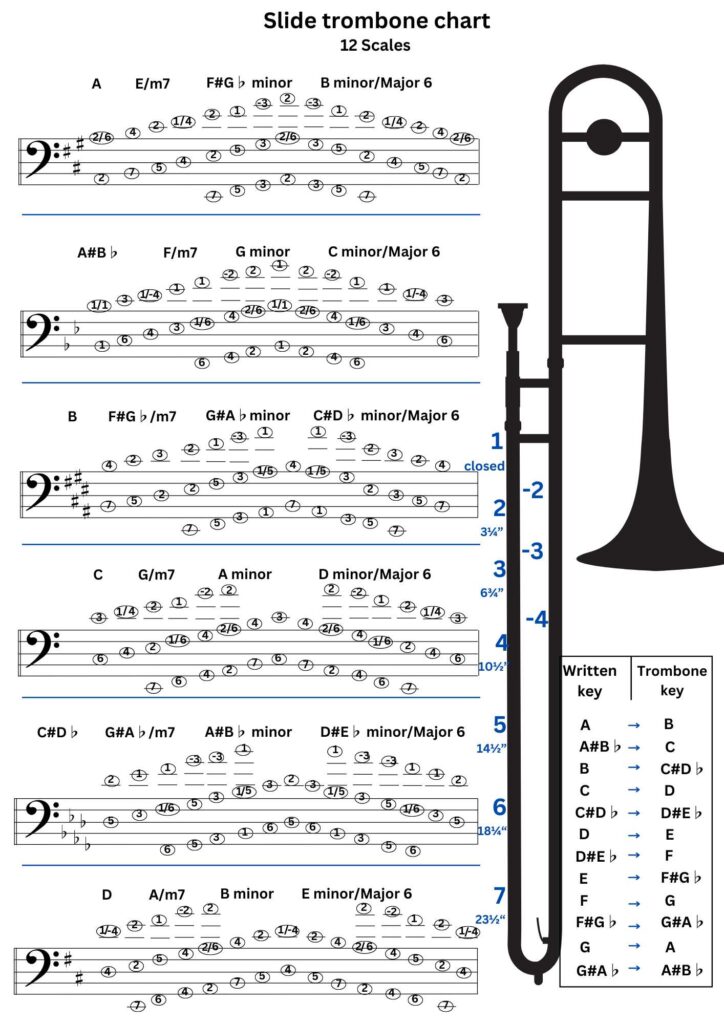
Trombone players often use these charts during practice and rehearsals to familiarize themselves with the instrument’s range and improve their accuracy.
By referencing the slide chart, you quickly locate the correct position to produce the desired pitch (enhancing their overall performance).
How to Read a Trombone Slide Chart
Reading a Trombone Slide Chart involves understanding the correlation between slide positions and the notes they produce — crucial for students learning to play in tune.
Understanding the Positions
Understanding the positions on a trombone involves recognizing that each slide position corresponds to a specific note in the harmonic series.
For beginners, the 1st slide position is typically used to play F. As you extend the slide, you transition into a higher note on the harmonic series. Moving the slide past the first position increases the length of the tubing, allowing you to play higher pitches.
Each slide position requires PRECISE placement for accurate intonation and a clear tone!! Master these positions for consistent sound quality and smooth transitions between notes.
Identifying Alternate Positions
Alternate positions on the trombone make specific passages easier to play (or to achieve better intonation), especially in fast musical passages!!
Identifying the need for alternate positions involves understanding the slide positions and how they relate to the harmonic series. For instance, transitioning between the C and Bb scales benefits alternate positions for smoother execution. [Learn more about scale in my other post, “Trombone Scales: Majors, Minors, Chromatic“]
In the piece ‘Blue Bells of Scotland,‘ a trombone player chooses alternate positions to navigate the rapid arpeggios.
Why is the Trombone Slide Chart Important?
The Trombone Slide Chart is important because it helps trombone players improve their accuracy and speed by providing a clear reference for correct slide positions, which is essential for playing in tune and mastering the instrument.
Improving Accuracy and Speed
Improving accuracy and speed on the trombone is facilitated by consistently practicing with a slide chart, which helps players quickly and accurately find the correct slide positions.
One effective exercise using the slide chart is to focus on memorizing the most common positions for different notes, enabling you to smoothly transition between them during performances.
Another helpful tip is to regularly test yourself by covering up the positions on the chart and trying to recall them from memory, promoting quicker reflexes.
Creating a practice routine that includes regular slide chart sessions can significantly improve your muscle memory and overall proficiency.
Mastering Alternate Positions
Mastering alternate positions on the trombone is crucial for navigating complex pieces of music and achieving smoother transitions between notes.
Learning alternate positions involves familiarizing yourself with different slide positions on the trombone to adjust the pitch of the notes. This process often includes exercises that focus on developing muscle memory and flexibility to switch between positions seamlessly.
Benefits of mastering alternate positions extend to various musical contexts, enabling trombone players to perform challenging pieces with greater accuracy and efficiency. By incorporating these positions into their repertoire, musicians can expand the range of notes they can play and enhance their overall technique.
Harmonic series of a bass or tenor trombone
A harmonic series of trombones is a set of musical notes that are produced by overtones on a single note. The lowest note is typically the root (fundamental) of the series, while the higher notes are mathematically related to that root.
The harmonic series provides the basis for many fundamental techniques in trombone playing, including vibrato, glissandos, and slides.
A brass player gets different notes by actually playing the harmonics WITHOUT changing the horn length. The brass instruments that get different notes from the same length of tubing are displayed on the 1st slide position chart. However, individual instruments will have a few notes that deviate from the rule.

Download FREE printable A4 poster of the Harmonic Series Chart here.
As the harmonic series progresses, the intervals between each note become progressively smaller, creating a stacked effect.
On the 1st slide position chart of a trombone, you can see the notes: Bb1, Bb2, F3, Bb3, D4, F4, Bb4, and so on, where the numbers indicate the octave. The first two notes form an octave, followed by a perfect fifth, a perfect fourth, a major third, a minor third, a major second, and so on.
Trombone harmonic series fall into two categories — the Fundamental and the Overtones.
The fundamental is the lowest note a trombone can play, and it provides the keynote — the foundation pitch.
Overtones, on the other hand, are higher notes you produce by manipulating the slide of the trombone. These overtone notes occur in the SAME harmonic series as the fundamental and are higher in pitch.
Brass instruments rely on the harmonic series to produce different notes without changing the length of the instrument. Trombones can EASILY adjust the harmonic series by simply changing trombone slide positions.
In case you are considering a new trombone, we have prepared a post with 7 Top Pick Trombones For Beginners And Students Under $1500 in 2023
Trombone Slide Positions Theory
The pitch of the sound produced by a trombone is controlled by changing the length of the tubing using the slide, which has seven positions numbered from 1st (closest to the person playing) to 7th (fully extended). Each slide position corresponds to a different note in the harmonic series.

Trombones can actually produce more than seven sounds even though they have only seven slide positions. Brass instruments can produce higher pitches beyond the fundamentals through an “overflowing” – increasing the speed of air and lip vibrations to achieve higher partials in the overtone series, resulting in a much larger range of notes that can be produced with each slide position.
The notes on each slide position chart are based on the harmonic series (or overtone series). The tubing does not have any markers to indicate these positions. Therefore, players must rely on their sense of touch to learn the positions. Please refer to the following trombone slide chart diagram to determine the approximate trombone slide positions and most common fingering chart.
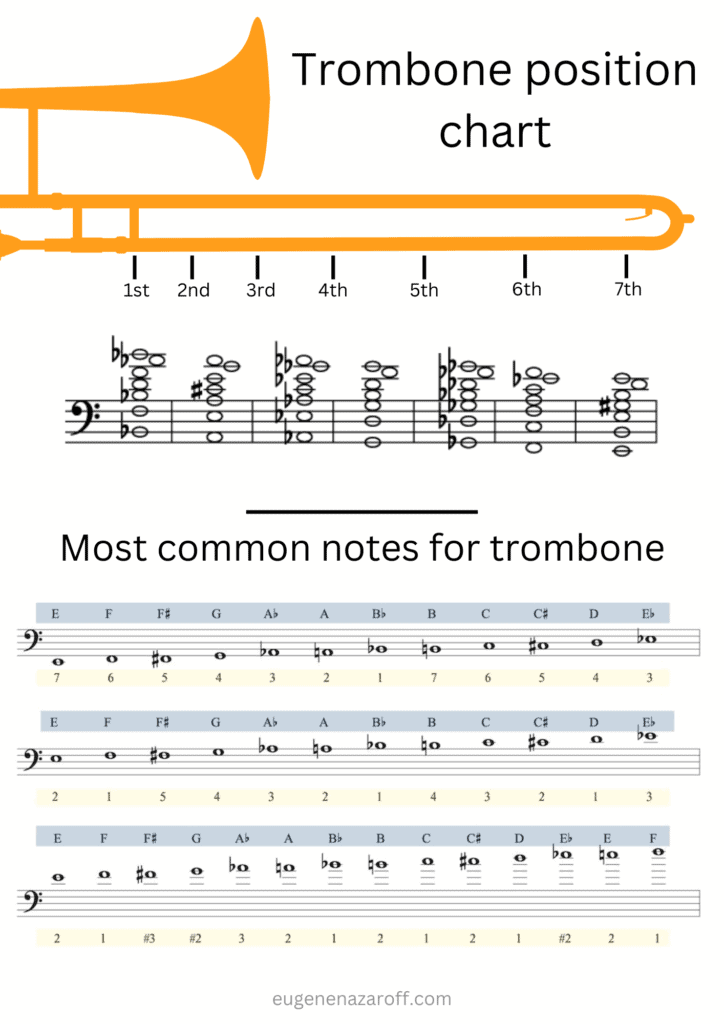
Download FREE printable A4 poster of the Trombone Slide Chart here.
The trombone notes are displayed at the bottom and relative to the slide. Note that the 3rd position is located a little before the bell, not exactly at it. Also, observe that the gap between each position increases slightly due to the natural acoustics laws, which indicate that half-steps of frequencies are not linear multiples of neighboring tone frequencies.
First trombone slide position
1st position (open) is with the slide all the way in. Take the bell section and get the smaller section, not the bell, on the longer end of the slide.
The first slide position of the tenor trombone Bb produces Bb, Bb, F, Bb, D, F, Ab, C, D, F, and other notes.
Second trombone slide position
The second position will be located approximately 2.5 inches, somewhere in between the 1st position and the end of the bell, but closer to the 1st position. Usually, you can expect to see around 1 to 1.5 inches of the inner slide silver’s width.
The 2nd slide position of the tenor trombone Bb lowers the pitch by a semitone producing A, A, E, A, C#, E, G, A, B, C#, E, and other notes.
Third trombone slide position
In the 3rd position, place the right-hand brace right before the bell. Your fingers should be positioned by the bell without actually touching it.
The third slide position of the tenor trombone Bb lowers the pitch by 2 semitones (a tone), producing Ab, Ab, Eb, Ab, C, Eb, Gb, Ab, Bb, C, Eb, and other notes.
Fourth trombone slide position
In the 4th position, the end of the slide should be placed just past the bell.
The fourth slide position of the tenor trombone Bb lowers the pitch by 3 semitones (a minor 3rd), producing G, G, D, G, B, D, F, G, A, B, D, and other notes.
Fifth trombone slide position
The 5th position is situated 4 inches away from the 4th position. It is positioned midway between the 4th and 6th positions but is closer to the 4th position because each position is slightly wider than the preceding one. For correct positioning, try placing your wrist about 2 inches past the bell between the bell and the stocking.
The fifth slide position of the tenor trombone Bb lowers the pitch by 4 Semitones (a major 3rd), producing Gb, Gb, Db, Gb, Bb, Db, Fb, Gb, Ab, B, Db, and other notes.
Sixth trombone slide position
Many people determine the level of extension in the sixth position by observing how far their arm is stretched out. It should be noted that arm lengths differ among players, so it is merely an approximate measure. The 6th position is just before the stockings, with the arm almost fully extended and the stocking bump not visible. If you notice the stocking bump, it means that you’ve moved the slide beyond the 6th position.
The sixth slide position of the tenor trombone Bb lowers the pitch by 5 semitones (a perfect 4th), producing F, F, C, F, A, C, Eb, F, G, A, C, and other notes.
Seventh trombone slide position
7th position is located past the stockings just before the slide falls off. Try to extend your shoulder as much as possible to reach the 7th position on the trombone slide. Some musicians may not need to extend fully to the seventh position if their arms are longer, so If you have difficulty reaching it, reach as far as you can. This position is mainly used for playing the low E and B-natural notes.
The seventh slide position of the tenor trombone Bb lowers the pitch by 6 semitones (an augmented 4th), producing E, E, B, E, G#, B, D, E, F#, G#, B, and other notes.
Are you feeling ready to play an advanced level trombone? Our blog covers the 7 Best Jazz Trombones of 2023, which we believe will be helpful for you.
Understanding Trombone Slide Position Chart
The notes on the trombone are derived from the harmonic series, also known as the overtone series. Contrary to popular belief, the number of available sounds is not limited to the 7 slide positions on the brass instrument. In fact, a trombone can produce multiple distinct sounds from a single slide position.
The trombone slide position chart provides the positions for notes on a “straight,” e.g., no valves, no F-attachment, tenor trombone in Bb. The lowest note that can be produced without using any valves is a pedal B-flat. This note is the fundamental pitch of an air column that vibrates in a tube approximately nine feet long. The pedal B-flat is a complex tone that includes all the notes listed above it and additional notes as well.
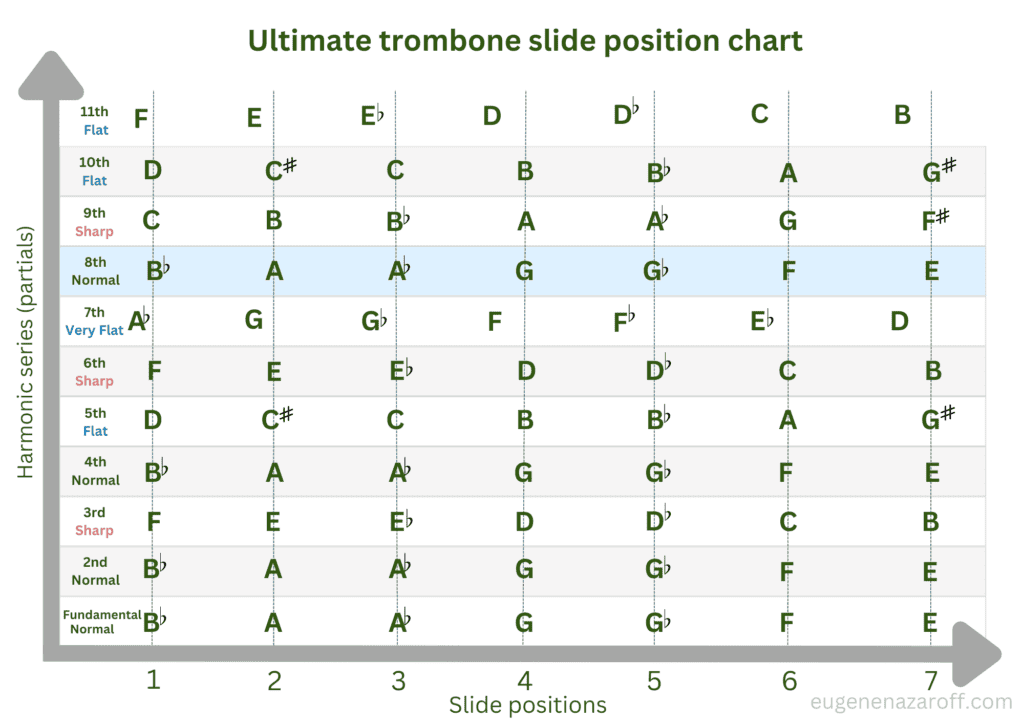
Download FREE printable A4 poster of the Ultimate Trombone Slide Position Chart here.
Above is an ultimate trombone slide chart for where each position is located on the tenor trombone, but it’s essential to keep in mind that each trombone has variations, so you should rely on your hearing to ensure that you’re playing in tune and remember that there are a lot of minute changes that need to be made when in specific partials. Looking at the diagram, determine how high or low you should “buzz” to produce the correct note.
You will be playing a high Eb in the 3rd position, but it won’t be in “true 3rd” because the 6th partial is naturally sharp. To play in tune, you will need to bring out the Eb slightly. This is something students discover when learning to play a high G. The 7th partial is very flat, so a G played in the 2nd position should actually be played in a position that’s somewhere between 1st and 2nd. There are also other overtones or partials that may require you to make slight adjustments to the trombone slide positions.
Third Partial
A typical brass instrument has an issue with the third partial not being in tune. Due to this, notes sound a little sharp and require trombone slides to be slightly farther out than they are usually displayed on the slide position chart. The D note can also be a bit flat when the G is in tune. Try making small adjustments to trombone slide positions to ensure all notes are in pitch.
Fifth Partial
The 5th partial is a musical interval of a major 3rd above the 4th harmonic and has a low pitch. Any note played on the 5th partial, as well as the 10th, will be slightly flat.
To play these notes correctly, you need to adjust the trombone slide positions inward from where you originally learned them for G. Do you notice that the G, B, and D notes sound out of tune?
Seventh Partial
The 7th partial is located a minor seventh above the 4th partial and has a very flat pitch. If you want to play these notes in tune, it’s best to avoid playing them as written. For instance, the high G on the 2nd position requires you to adjust the slide to in between the 1st and 2nd positions to get the right pitch.
Learning Trombone Position Chart For Beginners
The precise positioning doesn’t actually matter for learning the positions. There are certain notes provided that are considered false or wrong, meaning different from notes registered by a tuner. These notes should only be used with a modified position when faced with situations that require alternative positions. A trombone player can play different pitches out of the instrument with a combination of tightening or relaxing the lips and moving the slide.
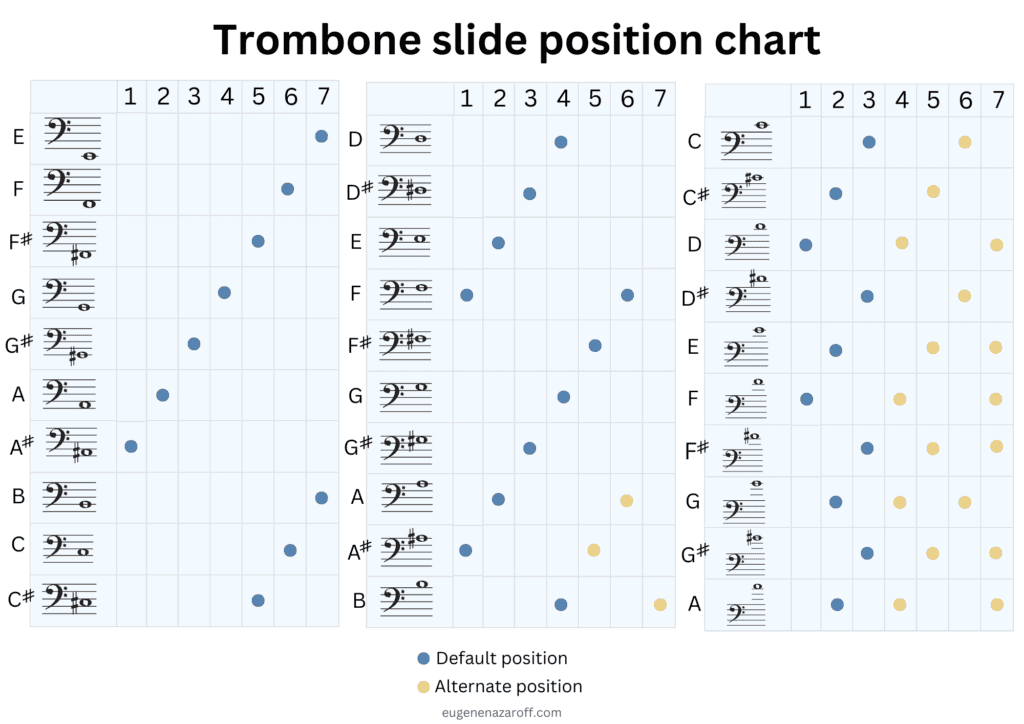
Download FREE printable A4 poster of the Trombone Slide Position Chart here.
The above is a trombone position chart showing the most common slide positions, but keep in mind that each trombone is unique, and you will need to rely on your ears to correctly position the slide for playing in tune. Your embouchure is responsible for producing both the tone and range of your playing. When playing higher partials such as 6, 7, 8, or 9, you need to use more air and have a stronger embouchure to get the desired sound from your instrument.
The first trombone slide chart notes are usually in concert pitch and on the trombone, Bb, C, D, Eb, and F, which suits as a great start for a beginner trombone player! When playing each note in this set of 5, be sure to re-form the “M” embouchure, center the mouthpiece comfortably on your lips, take a deep breath, and blow with the same amount of air pressure used to blow out birthday candles.
Understanding F-attachment
When the F-attachment is activated on your instrument, it adds an extra length of 5 positions and enables you to play 4 additional low notes. This feature works especially well for younger players who may have difficulty extending far to reach low C notes in the 6th position and 7th position notes in the 2nd position.
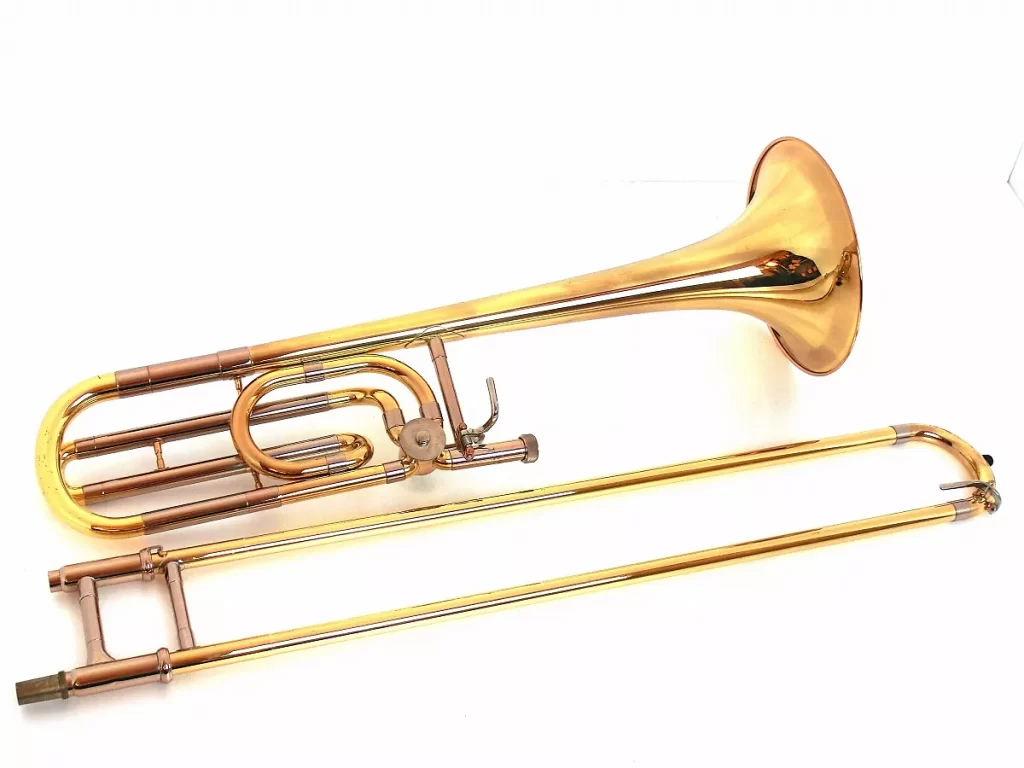
The trigger expands the instrument’s range and lets you play lower notes beyond the 2nd position to help bridge a gap between low E and pedal Bb. If you combine the F-attachment with a longer 2nd position, you can achieve the same tone as the 7th position (low B).
Extra materials
To learn the trombone slide chart effectively, it’s helpful to use multiple instructional materials from various teachers. I am sharing the top 3 resources for an even better understanding of trombone slide positions.
Trombone Slide Position Chart Printable Poster
Overview
This chart was created by a couple who love design and photography and want to inspire others to use it. It includes a C bass clef with no F-attachment, trombone parts and their names, a slide position chart, and a Bb harmonic series. Penny & Horse offers the chart in customizable sizes at no extra cost. Print at home instantly or take(email) the files to Coscto, Tagret, WalgreensPhoto, or any other copy shop like
Features
- Bright colors and neat design
- 5 high-resolution images ready to print
- Instant download once payment is confirmed
Pricing
Printable trombone position chart
Trombone Slide Position Chart Digital Book
Overview
The purpose of this book is to assist beginners in learning to play the trombone. The book provides trombone charts that display fingering positions, pitch names, and staff notations. Each page features a red slide position that corresponds to the depicted note. After purchasing the book, download the file and open it with any ePUB-reading application to begin your journey to the trombone slide position chart world.
Features
- 32 trombone colorfully diagrams, including alternate positions
- Covers almost 3 octaves from E2 to B4
- Great selection of trombone songs
- Star seller on Etsy
Pricing
Ebook with slide position chart
Learn to play trombone Ecourse on Udemy
Overview
The “Learn to Play Trombone: Go From Beginner to Pro in No Time” course offers a 6-hour on-demand video with popular songs and melodies. The course covers the assembly and maintenance of a trombone, parts of the trombone and mouthpiece, reading and interpreting music notation, and playing multiple major scales.
Join over 18,000 R. Benjamin Osborne and start your studies today! He has been serving as the second trombone of the Austin Symphony Orchestra since 2008 and was appointed as an Adjunct Instructor of Trombone at Sam Houston State University in Huntsville, Texas, in 2010, where he currently teaches.
Features
- 68 downloadable resources, over 120 video lessons
- Figure how to form a correct, strong trombone embouchure
- Master ultimate trombone slide char
- Access on mobile and TV
Pricing
Learn to play trombone Ecourse with slide position chart
Frequently Asked Questions
What is a trombone slide chart?
A trombone slide chart is a visual guide trombone players use to determine the correct positions for playing different notes.
How is a trombone slide chart organized?
A trombone slide chart has the different positions in numerical order, starting from the lowest note to the highest note on the instrument.
Are there different types of trombone slide charts?
Yes, there are different types of trombone slide charts available, such as tenor, alto, and bass trombone slide charts. These charts can vary in terms of the positions listed and the range of notes
What are alternate positions on a trombone slide chart?
Alternate positions on a trombone slide chart refer to additional positions to play the same note. These alternate positions make specific passages easier to play (and improve intonation)!!
How can I use a trombone slide chart to improve my playing?
REGULARLY practicing with the chart and focusing on correct positioning improve your overall playing technique.
What are some tips for using a trombone slide chart effectively?
Practice with the chart regularly, start with basic exercises, use a metronome, and consult with a teacher for advice.
[If you have some spare time, check out this list of the 13 Best Trombone Players Of All Time ]
